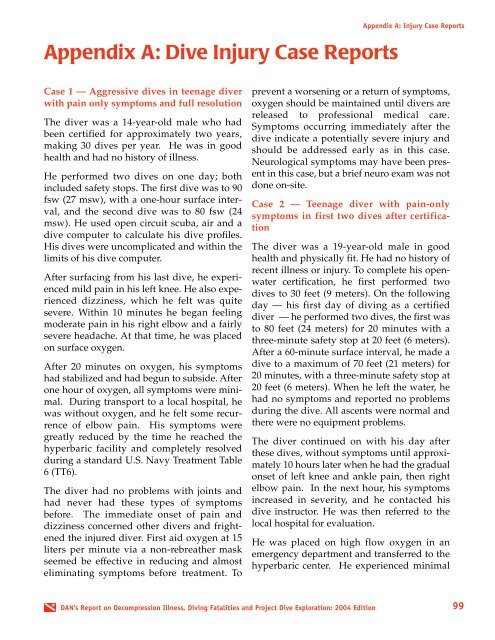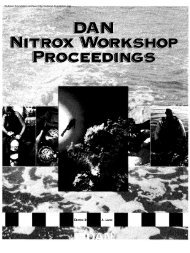Report on Decompression Illness, Diving Fatalities and Project Dive
Report on Decompression Illness, Diving Fatalities and Project Dive
Report on Decompression Illness, Diving Fatalities and Project Dive
- No tags were found...
You also want an ePaper? Increase the reach of your titles
YUMPU automatically turns print PDFs into web optimized ePapers that Google loves.
Appendix A: <strong>Dive</strong> Injury Case <str<strong>on</strong>g>Report</str<strong>on</strong>g>sAppendix A: Injury Case <str<strong>on</strong>g>Report</str<strong>on</strong>g>sCase 1 — Aggressive dives in teenage diverwith pain <strong>on</strong>ly symptoms <strong>and</strong> full resoluti<strong>on</strong>The diver was a 14-year-old male who hadbeen certified for approximately two years,making 30 dives per year. He was in goodhealth <strong>and</strong> had no history of illness.He performed two dives <strong>on</strong> <strong>on</strong>e day; bothincluded safety stops. The first dive was to 90fsw (27 msw), with a <strong>on</strong>e-hour surface interval,<strong>and</strong> the sec<strong>on</strong>d dive was to 80 fsw (24msw). He used open circuit scuba, air <strong>and</strong> adive computer to calculate his dive profiles.His dives were uncomplicated <strong>and</strong> within thelimits of his dive computer.After surfacing from his last dive, he experiencedmild pain in his left knee. He also experienceddizziness, which he felt was quitesevere. Within 10 minutes he began feelingmoderate pain in his right elbow <strong>and</strong> a fairlysevere headache. At that time, he was placed<strong>on</strong> surface oxygen.After 20 minutes <strong>on</strong> oxygen, his symptomshad stabilized <strong>and</strong> had begun to subside. After<strong>on</strong>e hour of oxygen, all symptoms were minimal.During transport to a local hospital, hewas without oxygen, <strong>and</strong> he felt some recurrenceof elbow pain. His symptoms weregreatly reduced by the time he reached thehyperbaric facility <strong>and</strong> completely resolvedduring a st<strong>and</strong>ard U.S. Navy Treatment Table6 (TT6).The diver had no problems with joints <strong>and</strong>had never had these types of symptomsbefore. The immediate <strong>on</strong>set of pain <strong>and</strong>dizziness c<strong>on</strong>cerned other divers <strong>and</strong> frightenedthe injured diver. First aid oxygen at 15liters per minute via a n<strong>on</strong>-rebreather maskseemed be effective in reducing <strong>and</strong> almosteliminating symptoms before treatment. Toprevent a worsening or a return of symptoms,oxygen should be maintained until divers arereleased to professi<strong>on</strong>al medical care .Symptoms occurring immediately after thedive indicate a potentially severe injury <strong>and</strong>should be addressed early as in this case.Neurological symptoms may have been presentin this case, but a brief neuro exam was notd<strong>on</strong>e <strong>on</strong>-site.Case 2 — Teenage diver with pain-<strong>on</strong>lysymptoms in first two dives after certificati<strong>on</strong>The diver was a 19-year-old male in goodhealth <strong>and</strong> physically fit. He had no history ofrecent illness or injury. To complete his openwatercertificati<strong>on</strong>, he first performed twodives to 30 feet (9 meters). On the followingday — his first day of diving as a certifieddiver — he performed two dives, the first wasto 80 feet (24 meters) for 20 minutes with athree-minute safety stop at 20 feet (6 meters).After a 60-minute surface interval, he made adive to a maximum of 70 feet (21 meters) for20 minutes, with a three-minute safety stop at20 feet (6 meters). When he left the water, hehad no symptoms <strong>and</strong> reported no problemsduring the dive. All ascents were normal <strong>and</strong>there were no equipment problems.The diver c<strong>on</strong>tinued <strong>on</strong> with his day afterthese dives, without symptoms until approximately10 hours later when he had the gradual<strong>on</strong>set of left knee <strong>and</strong> ankle pain, then rightelbow pain. In the next hour, his symptomsincreased in severity, <strong>and</strong> he c<strong>on</strong>tacted hisdive instructor. He was then referred to thelocal hospital for evaluati<strong>on</strong>.He was placed <strong>on</strong> high flow oxygen in anemergency department <strong>and</strong> transferred to thehyperbaric center. He experienced minimalDAN’s <str<strong>on</strong>g>Report</str<strong>on</strong>g> <strong>on</strong> Decompressi<strong>on</strong> <strong>Illness</strong>, <strong>Diving</strong> <strong>Fatalities</strong> <strong>and</strong> <strong>Project</strong> <strong>Dive</strong> Explorati<strong>on</strong>: 2004 Editi<strong>on</strong> 99
















